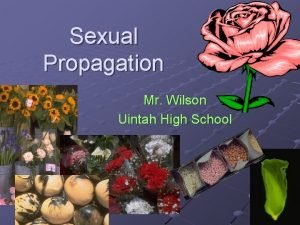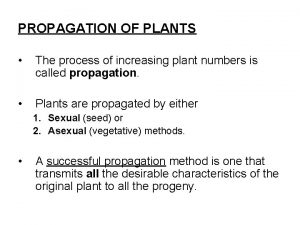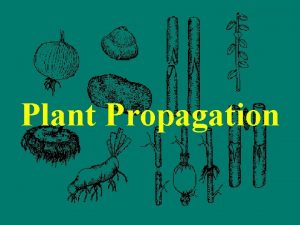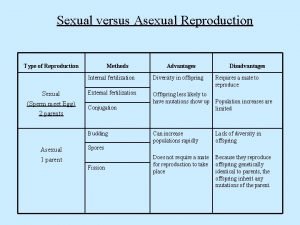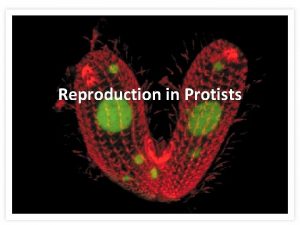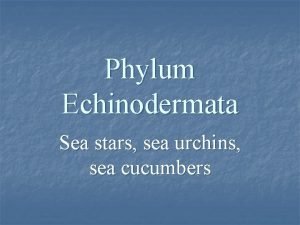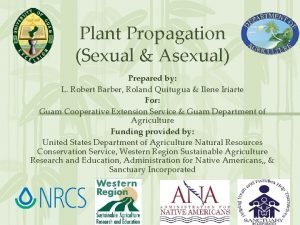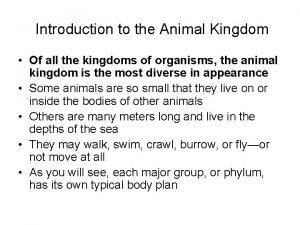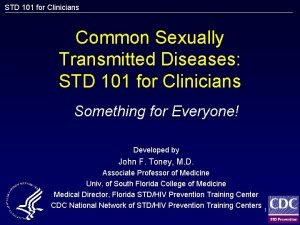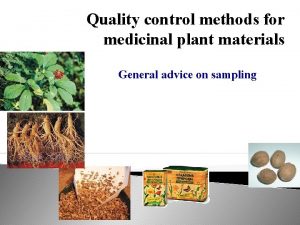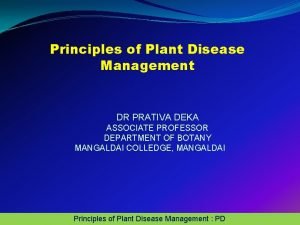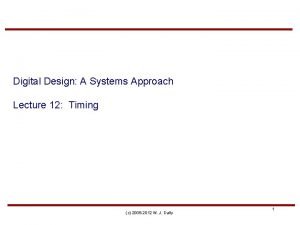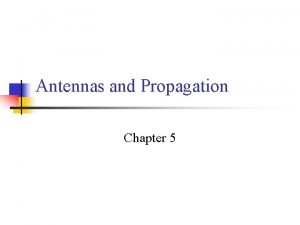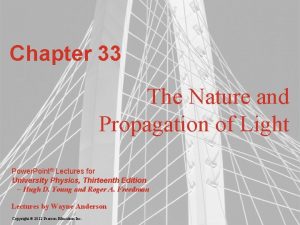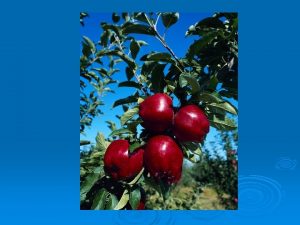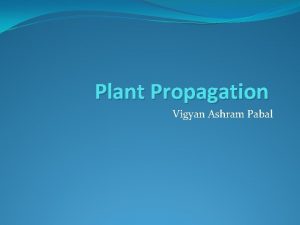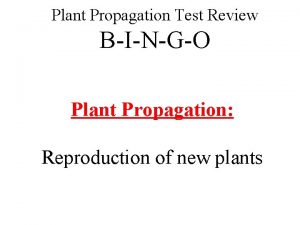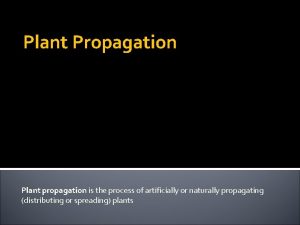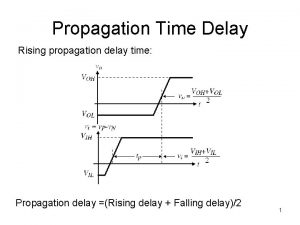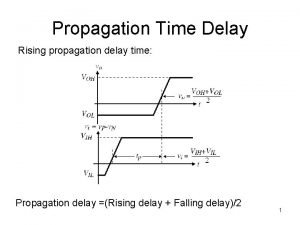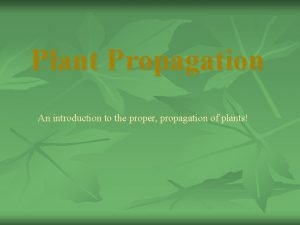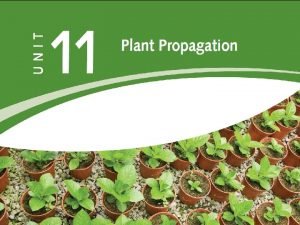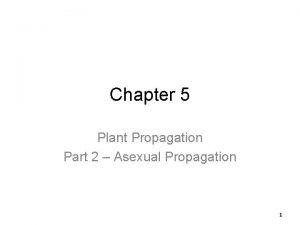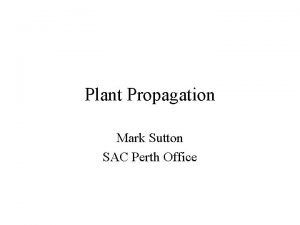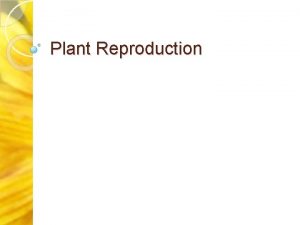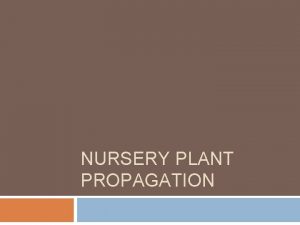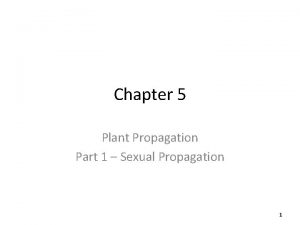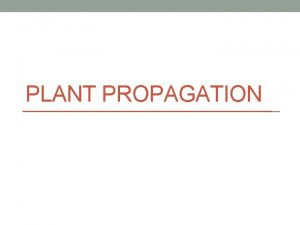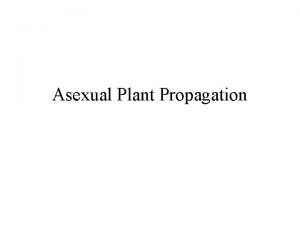4 02 Methods of Plant Propagation Sexually and






































- Slides: 38

4. 02 Methods of Plant Propagation Sexually and Asexually propagating plants

Plant Propagation n Sexual Propagation n n starting plants from seeds Germination rate n n n % that sprouts 75 of 100 = 75%. Rates are affected by temperature and moisture Rates vary depending on plant and quality (viability) of seed

Sexual Propagation n Seed viability is the seed’s capability of growing or developing n Seed viability is affected by temperature and moisture

Sexual Propagation n Plant seeds based on size of seeds n Plant seeds no more than 1. 5 times the diameter of the seed n Larger seeds are planted deeper n Smaller seeds are planted shallow n n Ex. Petunia seeds are TINY Water small seeds by bottom soaking to prevent burying them

Sexual Propagation n Seedlings n n The first sets of leaves are called cotyledons n n n small plants Monocots produce one seed leaf Dicots produce two seed leaves True leaves are the second set of leaves

Sexual Propagation n Transplant seedlings when the first true leaves appear n Before planting in the outdoor environment, reduce humidity and water and make environment more like outside to “harden off” plants.

Advantages of Sexual Reproduction 1. Fast way to get many plants. 2. Easy to do. 3. Economical.

Disadvantages of Sexual Reproduction 1. Some plants, especially hybrids, do not reproduce true to parents. 2. Some plants are difficult to propagate from seeds.

Sexual Propagation n Examples of plants started by seed are: n n n n Marigold Impatiens Begonia Coleus Salvia Shasta daisy Pansy

Plant Propagation n n Asexual Reproduction –starting plants by means other than seed Methods include: § § § § Cuttings Layering Division Separation Grafting Budding Tissue culture

Cuttings n Stem n n Start with sterile flats, soil, and tools Must include a node n A node is a point along a plant stem where leaves or other stems are attached n n Internode is the area between two nodes Cutting is taking a 4 -6 inch piece of the plant and forcing roots to grow

Cuttings o Using hormones help speed up rooting o Dipping the cutting in fungicides help prevent rotting o Rooting media should be about 4 inches deep

Cuttings n n n Herbaceous plants are soft-tissue plants Woody plants are plants that produce woody tissue Examples of plants that can be started by cuttings n n Herbaceous – geranium, impatiens, begonia and coleus Woody – holly, abelia, and rosemary

Cuttings n Leaf Usually propagated from herbaceous plants n Midrib vein must be cut in order to make roots form n Examples n n African violet and philodendron n Snake plant and jade plant

Cuttings n Root n n n Should be spaced three inches apart in rooting area A sand, vermiculite or perlite mixture is a good medium for root cuttings Examples: hosta and daylily

Cuttings n The best time of day to take a stem, leaf, or root cutting is early morning because plants have more moisture

Layering n n Tricking the plant stem into growing roots while still attached to the parent plant Examples n n n Air layering Trench Layering Mound Layering

Layering n Air layering n n Making an incision at the node of a branch Dust with rooting hormone, place sphagnum moss in plastic and wrap around the incision forcing roots to grow on the stem of the plant

Layering n Air layering n n Once roots form, remove below the new roots for a new plant Examples n Decora rubber plant n Weeping fig

Air Layering Some plants, like the spider plant, naturally layer.

Layering n Trench Layering - new plants form at each node along the stem while still attached to the plant n n n Is cutting a trench and laying a branch in the trench Types of trench layering are simple, tip, and serpentine Examples of plants for trench layering n n Grapes Clematis

Types of Trench Layering Simple Layering Tip Layering Serpentine Layering

Layering n Mound layering n n Is mounding the soil on a branch An example would be an azalea Mound Layering

Division n Cutting apart rhizomes, tubers, runners, stolons, or suckers to get new plants n n n Division is used on plants that grow in clumps Examples of plants that can be divided are hostas, daylilies, and irises Also used on some grasses

Separation n n Separating natural structures of a plant without making a cut Examples of plants: n Bulbs and corms

Grafting n Joining separate plant parts together so that they form a union and grow together to make one plant. n n Tools needed are a knife, tape, and wax Plants must be related to each other and normally in the same genus or family

Grafting n n n Scion is the piece of plant at the top of the graft Rootstock is the piece of the plant at the root or bottom of the graft Examples of plants that can be grafted: n n n Maples and fruit trees Sweetgum (fruitless sweetgum) Pecan

Budding n n A form of grafting when a bud is used. Types: T-budding, n Chip budding, n Patch Budding. n

Budding n Successful T budding requires: n n that the scion (top)material have fullyformed, mature, dormant buds, that the rootstock be in a condition of active growth such that the "bark is slipping". n This means that the vascular cambium is actively growing, and the bark can be peeled easily from the stock piece with little damage. n An example would be a rose

Budding Technique Removing the bud from the scion wood. Bud is inserted into the rootstock. Wound is wrapped for healing

1. 3. 5. 2. 4.

Tissue Culture (or Micropropagation) n This is the newest form of Asexual propagation

Tissue Culture (Micropropagation) n n A sterile environment is necessary for micropropagation (biotechnology) It is a good way to get the most plants in a short period of time It will give you a plant identical to the parent plant (clone) An example would be impatiens and many flowers and vegetable plants

Asexual Propagation Terms n 1. Corm - Enlarged, bulb-like, fleshy base of a stem. Usually flattened and round. Ex: gladiolus and crocus n 2. Rhizome - a creeping underground stem, usually horizontal, that produces roots and leaves at the nodes. Ex: cannas and bearded Iris

Asexual Propagation Notes: 3. Stolon (or Runner) – a creeping above ground stem that grows horizontally and produces roots and shoots at the nodes. Ex: strawberry 4. Tuber – a swollen, modified stem that grows underground. Ex: potato 5. Sucker - a shoot or stem that originates from the roots.

Asexual Propagation Methods in Review n n n n Cuttings Layering Division Separation Grafting Budding Tissue Culture

Advantages of Asexual Propagation n n Asexual reproduction or propagation-plants mature in shorter time. Budding is faster or quicker than grafting. In trench layering, plants form at each node on covered stems. Some plants do not produce viable seeds. New plants are same as parent plant.

Disadvantages of Asexual Propagation n Some require special equipment and skills, such as grafting. Cuttings detach plant parts from water and nutrient source. Some plants are patented making propagation illegal.
 Simple layering examples
Simple layering examples Advantages of plant propagation
Advantages of plant propagation Mist chamber ppt
Mist chamber ppt Chapter 25 sexually transmitted infections and hiv/aids
Chapter 25 sexually transmitted infections and hiv/aids Chapter 24 sexually transmitted diseases and hiv/aids
Chapter 24 sexually transmitted diseases and hiv/aids Spongocoel
Spongocoel How do whales reproduce sexually
How do whales reproduce sexually Nematoda
Nematoda Parasitism phylum
Parasitism phylum Run away selection
Run away selection Coercion
Coercion Reproduction of protists
Reproduction of protists Was it sexual abuse quiz
Was it sexual abuse quiz Do sea urchins reproduce sexually or asexually
Do sea urchins reproduce sexually or asexually Structure of protists
Structure of protists Chapter 24 lesson 1 sexually transmitted diseases
Chapter 24 lesson 1 sexually transmitted diseases Orgasm
Orgasm Do worms reproduce sexually or asexually
Do worms reproduce sexually or asexually Have i been sexually harassed quiz
Have i been sexually harassed quiz Sexual propagation
Sexual propagation Cnidaria class
Cnidaria class Sti std
Sti std Radial symmetry
Radial symmetry Sexually transmitted diseases
Sexually transmitted diseases Unpathetic freightment
Unpathetic freightment Sexually transmitted disease
Sexually transmitted disease How do birds have sexually reproduce
How do birds have sexually reproduce Sexually dimorphic meaning
Sexually dimorphic meaning Sex offender evaluation illinois
Sex offender evaluation illinois Tronsmo plant pathology and plant diseases download
Tronsmo plant pathology and plant diseases download Tronsmo plant pathology and plant diseases download
Tronsmo plant pathology and plant diseases download Tronsmo plant pathology and plant diseases download
Tronsmo plant pathology and plant diseases download Wax pattern in fpd
Wax pattern in fpd Quality control methods for medicinal plant materials
Quality control methods for medicinal plant materials Natural asset companies
Natural asset companies Deka vitaminok
Deka vitaminok Propagation delay and contamination delay
Propagation delay and contamination delay Antennas and propagation
Antennas and propagation Nature and propagation of light
Nature and propagation of light
